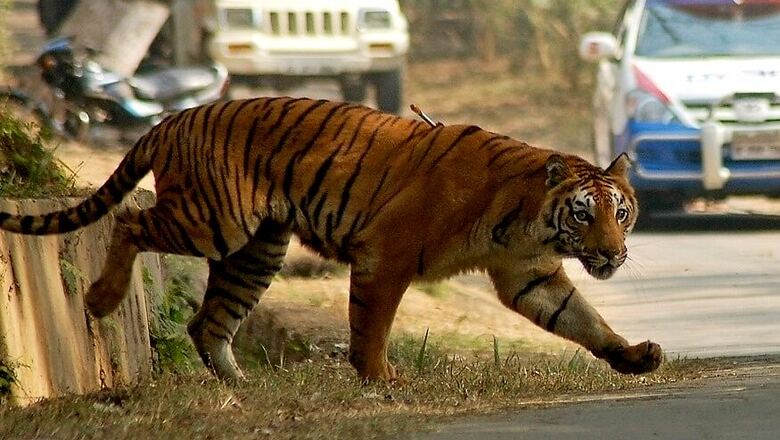
views
After a long delay, the Union environment minister Prakash Javadekar released the detailed 656–page report on the All India Tiger Population Estimation, 2018, on the eve of Global Tigers Day.
In 2019, Prime Minister Narendra Modi had announced that India had 2,967 wild tigers. The National Tiger Conservation Authority (NTCA) and Wildlife Institute of India (WII) had arrived at this number after sifting through a record-breaking 3.4 crore photographs that were obtained from camera traps placed at 26,838 locations.
Though the tiger population has increased over the year, the government’s detailed report has flagged several issues which need immediate attention, as these issues have the potential to sour the conservation success story.
Tiger conservation is chiefly centred on protected areas such as tiger reserves, national parks and regional landscape-level. And within regional landscapes, there are tiger corridors which serve as crucial habitat for them outside of notified parks and reserves.
Broadly, there are between 33-35 major tiger corridors and several smaller ones in the country. The report clearly states that there are several fragmentation threats to these corridors due to burgeoning development and infrastructure projects along with anthropogenic pressures.
The NTCA and WII report- ‘Status of tigers, co predators and prey in India’, stated that many tiger reserves and protected areas in India are analogous to small islands in a vast sea of ecologically unsustainable land uses of varying degrees. “Many tiger populations are confined within small protected areas and some have habitat corridors that permit tiger movement between them. However, most of the corridor habitats in India are not protected areas, and are degrading due to unsustainable human use and developmental projects,” the report reads.
Tiger corridors are the connecting source of tiger population- for ensuring genetic exchange through dispersal and as an alternative habitat to protect them from man-made and natural disasters. These landscapes are – Shivalik and Gangetic Plains; Central India and the Eastern Ghats, the Western Ghats, North Eastern Hills and Brahmaputra floodplains, and Sundarban. The government’s report has also detailed the fragmentation and existential threats to corridors within these landscapes.
Fragmentation of tiger corridors and habitats
The Achanakmar-Kanha-Pench corridor is home to the largest contiguous tiger population- 308 tigers in the Central Indian landscape. While the source populations of Kanha and Pench national parks in Madhya Pradesh have shown sustained growth in tiger numbers. However, the population of Achanakmar Tiger Reserve in Chhattisgarh continues to slide.
The reports further state that there are infrastructure interruptions in these corridors, as the Highway 12A traverses the core zone of Kanha Tiger Reserve and Phen Wildlife Sanctuary. To add, the Bodai-Daldali bauxite mines are also located within this corridor.
Kanha Reserve, in turn, is also connected to its south to Maharashtra’s tiger population in Tadoba and Navegaon-Nagzira and to Indravati tiger reserve in Chhattisgarh. However, the corridor between Tadoba and Indravati is fragmented by the National Highway (NH) 6, thus affecting connectivity to Telangana as well.
Not only connectivity, NH6 and NH7, which traverses the Kanha-Pench corridor poses a threat of speeding vehicles.
Meanwhile, in southern India’s Western Ghat tiger landscape, highways are affecting connectivity between tiger habitats. “Movement of tigers from the high-density source of Nagarahole-Mudumalai-Wayanad to sink habitats of Kudremukh-Bhadra complex is likely to be an important component for tiger population dynamics in this low-density landscape. Two National Highways (234, 48) and State Highways (8, 27, 37, 85, 88, 89, 91, 114) traverse through these corridors at various places. Development along these roads needs to be monitored and controlled within forested areas,” the report states.
In Southern India, the Wayanad wildlife sanctuary shares its north-eastern border with Nagarhole and Bandipur reserves in Karnataka and Mudumalai in Tamil Nadu. “Expansion of the urban sprawl of Kutta township threatens the habitat connectivity of Wayanad with Brahmagiri and Brahmagiri with Nagarhole. Wayanad is connected to the Silent Valley NP in Kerala through Mudumalai and Mukurti in Tamil Nadu," the report added.
Even as highways and railway lines get planned through these corridors, the government has also recommended a few mitigation measures, which includes, wildlife passages to ameliorate the impact of these infrastructure projects. However, following a long legal battle in National Green Tribunal, Delhi, and in Nagpur bench of the Bombay High Court, the National Highways Authority of India agreed to build a wildlife passage on NH7 in order to help the movement of tigers, bears and leopards between the Kanha-Pench corridor.
“The government of India has guidelines in place that outline the mitigation measures to reduce the impact of infrastructure projects. These mitigation measures though have to be site-specific to be functionally viable in the tiger corridors,” SP Yadav, Additional Director-General of Forests (Project Tiger) and Member Secretary NTCA, said.




















Comments
0 comment